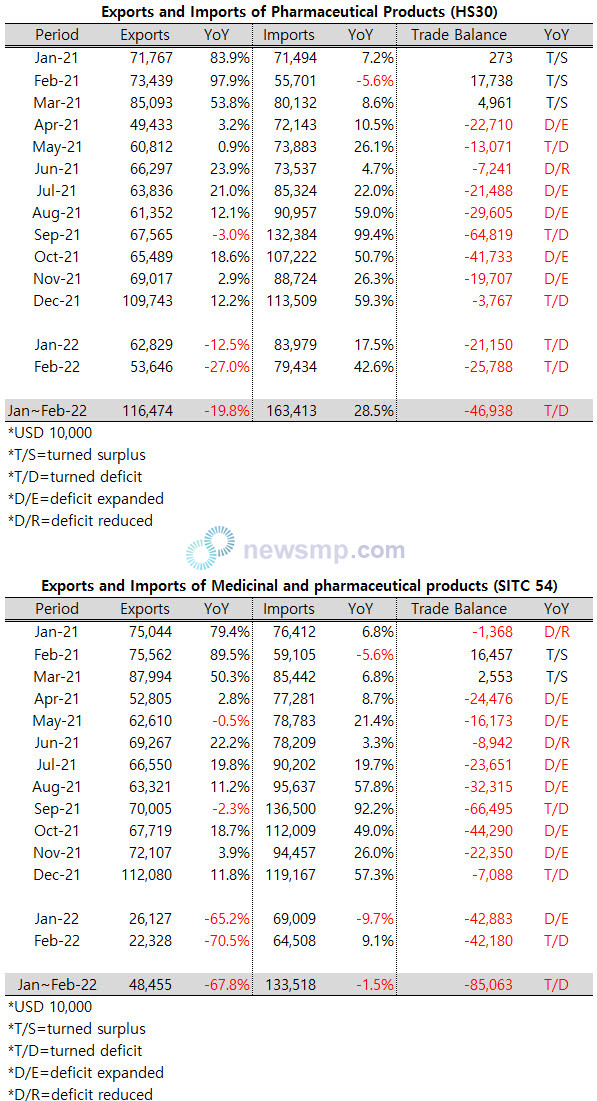Korea International Trade Association SITC Code, $1.12 billion → $220 million
[Newsmp] As exports of pharmaceutical products have decreased significantly since its peak in December last year, there are significant differences depending on the code.
The Korea Customs Service’s HS-30 based pharmaceutical products exports in February fell by half from last December, but the Korea International Trade Association’s SITC 54-based exports fell more than 80% during the same period.
Last year, both codes have shown similar trends without significant deviations, but remarkable differences have occurred since this year as some HS codes such as vaccines and cell therapy have been revised.

According to the HS30 Code, last year’s pharmaceutical products exports had risen steadily to the $600 million and $700 million mark until November, except that the exports plunged to the $400 million mark in April after exceeding the $800 million mark once in March.
Then, in December, monthly exports have soared to nearly $1.1 billion, reflecting the effects of vaccine exports.
During the same period, pharmaceutical imports continued to fluctuate between $700 million and $800 million until July, except for one time in February, which fell to the $500 million mark.
However, since August, when the COVID-19 vaccination began in earnest, imports of pharmaceutical products soared to the $1.3 billion mark for the first time in September, and since then, the imports exceeded the $1 billion mark twice more in October and December.
In the meantime, the imports and exports of pharmaceutical products based on the SITC54 Code showed almost the same trend.
Exports surpassed $800 million in March, then declined to $500 million in April, hovered around $600 and $700 million until November, and then surged to $1.1 billion in December.
Except for staying at the $500 million mark once in February, imports also rose to the $1.3 billion mark in September after going up and down between the $700 and $900 million mark until August and exceeded $1 billion twice in October and December.
Neither of the two codes showed much difference in monthly imports and exports or overall trends.
However, there is a significant difference this year.
Pharmaceutical products exports based on the HS30 code fell from $1.1 billion in December to about $630 million in January and $504 million in February. Compared to that of December, it is half the level and a decrease of 27% compared to the same period of the previous year.
Imports decreased from $1.135 billion in December to $840 million in January and $790 million in February but increased significantly from the same period last year.
Nevertheless, the deficit reached the $200 million mark per month, recording a total deficit of $470 million for two months.
The exports and imports of pharmaceutical products of SITC 54 were similar, but the situation was more serious.
Exports fell from $1.1 billion in December to $261.7 million in January and $223.28 million in February. This is a drop of more than 80% compared to December and more than 70% compared to the same period of the previous year.
Imports also fell by nearly half from $1.2 billion in December to $690 million in January and $650 million in February.
Compared to the same period last year, exports fell by nearly 10% in January and increased by nearly 10% in February, maintaining a two-month imports similar level as the same period last year.
It is quite different from the HS30 code, which is counted to have increased by nearly 30% over the same period.
Moreover, SITC54’s pharmaceutical products exports have decreased notably compared to the HS30 Code this year, showing a huge difference in terms of deficit.
The SITC54 trade deficit exceeded $400 million for the second consecutive month with $428.83 million in January and $421.8 million in February, nearly doubling the cumulative deficit of the HS30 Code.


